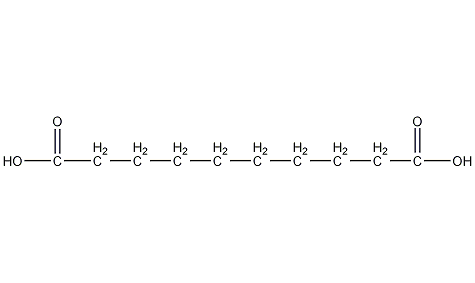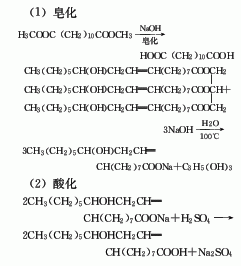Sebacic Acid Sebacic Acid


Structural formula
| Business number | 032Z |
|---|---|
| Molecular formula | C10H18O4 |
| Molecular weight | 202.25 |
| label |
Sebic acid, Suberic acid, Oct-1,8-dicarboxylic acid, secretion acid, 1,8-Octanedicarboxylic acid, Decanedioic acid, softener, plasticizer, acid solvents, acidic solvent |
Numbering system
CAS number:111-20-6
MDL number:MFCD00004440
EINECS number:203-845-5
RTECS number:VS0875000
BRN number:1210591
PubChem number:24857096
Physical property data
1. Properties: White flaky crystals, flammable.
2. Density (g/mL, 20/4℃): 1.2705
3. Melting point (ºC): 13.9
4. Boiling point (ºC, 2.0kPa): 249.5
5. Boiling point (ºC, 13.3kPa): 232
6. Refractive index (134ºC): 1.422
7. Flash point (ºC): 220
8. Solubility: Slightly soluble in water, hardly soluble in benzene, petroleum ether, carbon tetrachloride, easily soluble in ethanol and ether.
9. Refractive index at room temperature (n25): 1.422133
10. Critical temperature (ºC): 571.85
11. Critical pressure (MPa): 2.50
12. Gas phase standard combustion heat (enthalpy) (kJ·mol-1): -5585.6
13. Gas phase standard claimed heat (enthalpy) (kJ·mol-1): -922.2
14. Crystal phase standard combustion heat (enthalpy) ( kJ·mol-1): -5424.97
15. Crystal phase standard claims heat (enthalpy) (kJ·mol-1): -1082.61
Toxicological data
1. Acute toxicity: Oral LD50 in rats: 14375mg/kg; Inhalation LC50 in rats: >4500mg/m3
Oral LD50 in mice: 500mg/kg
2. Other multiple dose toxicity: Rat oral TDLO: 2887mg/kg/33W-I
Rat inhalation TCLO: 460ug/m3/24H/17W-C
Rat Inhalation TCLO: 410mg/m3/30D-I
3. Toxic when taken orally. Irritating to eyes, respiratory system and skin. Protective clothing should be worn when using.
Ecological data
Slightly harmful to water.
Molecular structure data
1. Molar refractive index: 51.50
2. Molar refractive index: 51.50
2. Molar refractive index� Volume (cm3/mol): 182.8
3. Isotonic specific volume (90.2K): 473.5
4. Surface tension (dyne/cm) : 44.9
5. Polarizability (10-24cm3): 20.41
Compute chemical data
1. Hydrophobic parameter calculation reference value (XlogP): 2.1
2. Number of hydrogen bond donors: 2
3. Number of hydrogen bond acceptors: 4
4. Number of rotatable chemical bonds: 9
5. Number of tautomers:
6. Topological molecular polar surface area (TPSA): 74.6
7. Number of heavy atoms: 14
8. Surface charge: 0
9. Complexity: 157
10. Number of isotope atoms: 0
11. Determine the number of atomic stereocenters: 0
12. Uncertain number of atomic stereocenters: 0
13. Determine the number of chemical bond stereocenters Number: 0
14. Number of uncertain chemical bond stereocenters: 0
15. Number of covalent bond units: 1
Properties and stability
1. Avoid contact with oxides. Protective clothing should be worn when using.
2.Sebacic acid is basically non-toxic, but the cresol used in production is toxic, so poisoning must be prevented (see cresol). Production equipment should be airtight. Operators should wear masks and gloves.
3. Found in flue-cured tobacco leaves, burley tobacco leaves, and oriental tobacco leaves.
Storage method
1. Packing in sacks or woven bags lined with plastic bags. Store in a cool and ventilated place. 2. Packed in woven bags or sacks lined with plastic bags, with a net weight of 25kg, 40kg, 45kg or 50kg per bag. Store in a cool and ventilated place, fire-proof and moisture-proof. Do not mix with liquid acid and alkali. Store and transport according to regulations for flammable products.
Synthesis method
Made from natural castor oil or adipic acid monoester. Sebacic acid can also be obtained through the polymerization reaction of ethylene and carbon tetrachloride, but currently almost all the sebacic acid produced industrially in the world uses castor oil as raw material.
1. Castor oil cracking method: castor oil is heated and hydrolyzed under the action of alkali to form sodium ricinoleate soap, and then sulfuric acid is added to acidolyze to form ricinoleic acid; In the presence of diluent cresol, add alkali and heat to 260-280℃ is cracked to generate sebacate disodium salt, sec-octanol and hydrogen, and the lysate is diluted with water , heat and add acid to neutralize, turning the disodium salt into monosodium salt; then use the neutralized liquid after activated carbon decolorization to boil and add acid, so that the monosodium sebacic acid salt becomes sebacic acid and crystallizes out, and then is separated and dried The finished product is obtained.
Raw material consumption quota: castor oil (industrial product)2100kg/t, sulfuric acid (98%)1600kg /t, caustic soda (95%)1200kg/ t, cresol (industrial product)100kg/t.


2, petroleum n-decane fermentation method200# solvent oil or 166-182℃ Isolated from the fraction N-decane is produced from sebacic acid by fermentation of 19-2 Candida lipolytica.
3. The new cyclopentanone method uses palladium salt– copper or iron as catalyst. In ethanol, propanol or other alcohol solvents, in 40–60℃under the mild conditions of low temperature and normal pressure , cyclopentene is oxidized with air to form cyclopentanone, which is then oxidized and dimerized with an iron catalyst.
4. Tobacco: OR, 44; BU, 18; FC, 54.
Purpose
It is mainly used to manufacture cold-resistant plasticizers such as dibutyl sebacate, dioctyl sebacate, diisooctyl sebacate and dialkyl sebacate. It can also be used to produce raw materials for nylon 1010, nylon 910, nylon 810, nylon 610, and nylon 9, as well as raw materials for producing high-temperature resistant lubricating oil diethylhexyl. It is also a raw material for the production of alkyd resins (used as surface coatings, plasticized nitrocellulose coatings and urea resin varnishes) and polyurethane rubber. Plasticizer, softener and solvent for cellulose resin, vinyl resin and synthetic rubber.
id=”yt”>Purpose
It is mainly used to manufacture cold-resistant plasticizers such as dibutyl sebacate, dioctyl sebacate, diisooctyl sebacate and dialkyl sebacate. It can also be used to produce raw materials for nylon 1010, nylon 910, nylon 810, nylon 610, and nylon 9, as well as raw materials for producing high-temperature resistant lubricating oil diethylhexyl. It is also a raw material for the production of alkyd resins (used as surface coatings, plasticized nitrocellulose coatings and urea resin varnishes) and polyurethane rubber. Plasticizer, softener and solvent for cellulose resin, vinyl resin and synthetic rubber.